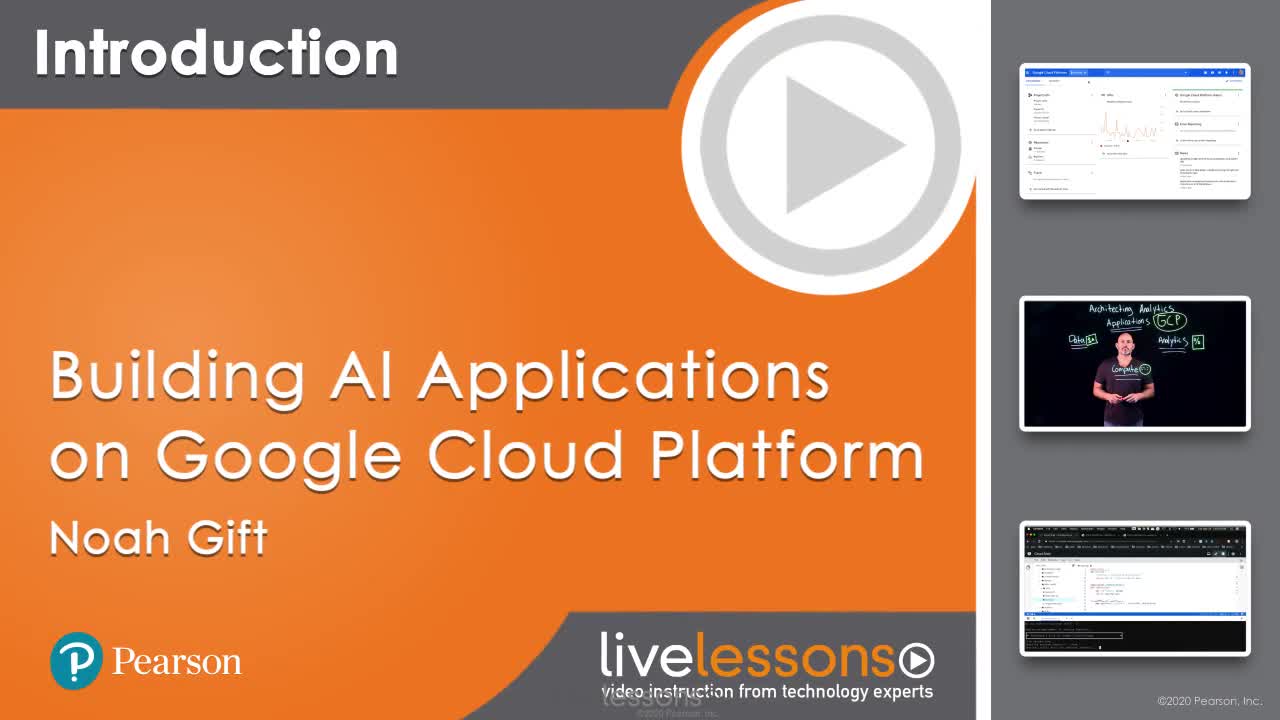Building AI Applications on Google Cloud Platform LiveLessons (Video Training)
- By Noah Gift
- Published Aug 12, 2019 by Addison-Wesley Professional.
Online Video
- Sorry, this book is no longer in print.
- About this video
Video accessible from your Account page after purchase.
Register your product to gain access to bonus material or receive a coupon.
Description
- Copyright 2020
- Edition: 1st
- Online Video
- ISBN-10: 0-13-597350-3
- ISBN-13: 978-0-13-597350-9
4+ Hours of Video Instruction
There is a rapid evolution occurring in machine learning with tools like AutoML that basically automate many of the tedious aspects of machine learning and allow developers to focus on getting results into production. Noah Gift illustrates just now to harness this technology and deploy it successfully on Google Cloud Platform, demonstrating for developers how to employ the current best practices and automated tools to create analytics applications that solve real-world problems.
Developers who want to take their Data Science skills to the next level and build AutoML applications in the Cloud will benefit from this unique course as they learn how to use AutoML, Big Query, Python, and Google App Engine to create sophisticated AI.
Description
Cloud AutoML is a suite of machine learning products that allows developers with limited machine learning expertise to train high-quality models specific to their business needs. It relies on Google’s state-of-the-art transfer learning and neural architecture search technology. Developers use Cloud AutoML’s graphical user interface to train, evaluate, improve, and deploy models based on their data.
Building AI Applications on Google Cloud Platform LiveLessons covers programming components essential to the development of AI and Analytics applications. The focus is on building real-world software engineering applications on the Google Cloud Platform. Several emerging technologies are used to demonstrate the process, including AutoML and Google BigQuery. The Python language is used throughout the course, as Python is becoming the de facto standard language for AI application development in the cloud.
Skill Level
- Beginning to Intermediate
What You Will Learn
Developers will learn how to:
- Develop analytics applications using Python and GCP
- Deploy analytics application on GCP
- Learn to implement production AutoML
- Solve real-world business problems
Who Should Take This Course
Primary: Data Scientists, Data Engineers, Software Engineers
Secondary: Graduate and Undergraduate students of Data Science, Data Engineering, and Computer Science
Course Requirements
Prerequisites:
- Python: 6 months or greater.
- Basic understanding of both Linux and cloud computing
About Pearson Video Training
Pearson publishes expert-led video tutorials covering a wide selection of technology topics designed to teach you the skills you need to succeed. These professional and personal technology videos feature world-leading author instructors published by your trusted technology brands: Addison-Wesley, Cisco Press, Pearson IT Certification, Prentice Hall, Sams, and Que. Topics include: IT Certification, Network Security, Cisco Technology, Programming, Web Development, Mobile Development, and more. Learn more about Pearson Video training at http://www.informit.com/video.
Video Lessons are available for download for offline viewing within the streaming format. Look for the green arrow in each lesson.
Sample Content
Table of Contents
Overall Introduction
Lesson 1: Create an Application Skeleton on GCP using Google App Engine
Learning objectives
1.1 Set up gcloud environment
1.2 Create Hello World application
1.3 Deploy Hello World application
1.4 Modify and re-deploy Hello World application
1.5 Architect Analytics Applications overview
Lesson 2: Build ETL (Extract Transform Load) Pipelines
Learning objectives
2.1 ETL overview
2.2 Data flow demo
2.3 Cloud functions
2.4 GAE Cron jobs
Lesson 3: Use ML Prediction on BigQuery
Learning objectives
3.1 Introduction to Big Theory
3.2 Create Supervised ML predictions with BigQuery
3.3 Create K-Means Clustering with BigQuery
Lesson 4: Use AutoML
Learning objectives
4.1 AutoML overview
4.2 Use AutoML Vision
4.3 Use AutoML Tables
Lesson 5: Use AI Platform
Learning objectives
5.1 Explore AI APIs
5.2 Predict with AI Platform
5.3 Use Notebooks for Data Science explorations
Lesson 6: Build an Analytics Application from Scratch
Learning objectives
6.1 Create a new Analytics application from scratch
6.2 Build queries against BigQuery
6.3 Enhance an Analytics application
6.4 Enable functionality in an Analytics application
Lesson 7: Using Build Systems and Containers
Learning objectives
7.1 Architect continuous deployment systems
7.2 Configure your repository in Github
7.3 Configure makefile in Google Cloud Shell
7.4 Build your project in CircleCI
Lesson 8: Course Overview
8.1 Course overview
Summary
